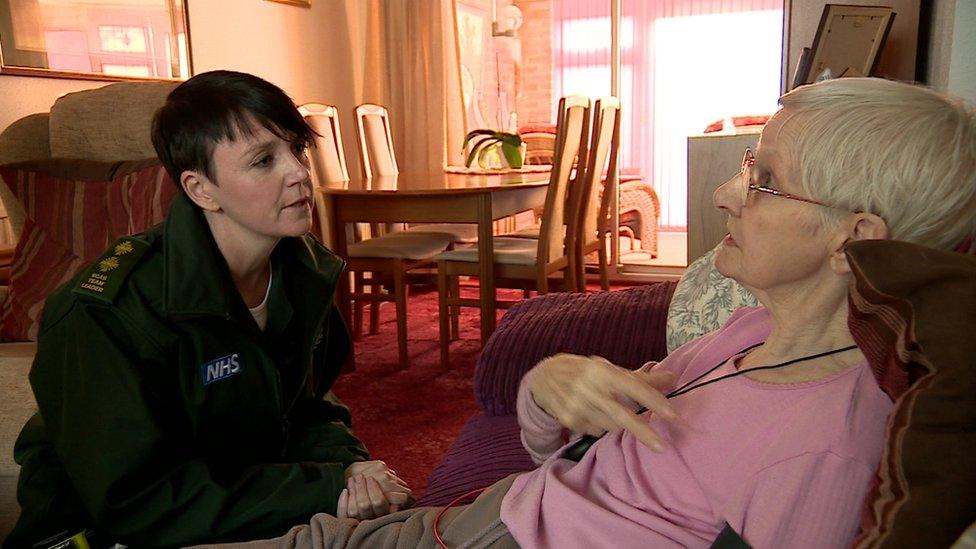What ambulance pressures tell us about strain on NHS
- Published

Kerry and Mark were called to help Irene who was complaining of chest pains
A day on the road with South Central Ambulance Service in Oxfordshire underlined the demographic challenges to the wider NHS.
Contrary to the impression that paramedics spend most of their time dealing with serious road traffic accidents or major injuries, it is clear increasing chunks of their shifts are devoted to caring for the elderly in local communities.
In a sense, they are stepping in when an overstretched GP service and underfunded social care system can't help.
Irene, a woman in her 80s, who lives alone, told her carer she had chest pains, so an ambulance was called.
The team, Kerry and Mark, established there was nothing life-threatening and that the pain might relate back to previous surgery.
Irene agreed it would be best to speak to her GP - but Kerry and Mark had to wait until the local practice rang back to confirm an appointment.
During that time, they prepared breakfast for the patient. The GP later disclosed that the patient - and her condition - was well known in the surgery.
Irene revealed that because she lived alone, she was anxious her surviving relatives would be away at Christmas.
A visit, even from ambulance staff, cheered her up. But it used up an hour of ambulance time.
An emergency response team had been deployed for what turned out to be a community health issue.
Intense pain
Later in the day, Kerry and Mark were called to a 92-year-old woman, Florence, who lives at home, cared for by her daughter.
She has an infection and is experiencing intense pain. They discussed treatment possibilities in the local area, but decided that going to hospital was the only option.
WATCH: The father and son ambulance team
Florence has been treated in the past for breast cancer. She has had both knee joints replaced. She now has bladder cancer as well as the infection, which is causing immediate pain.
In many ways, her situation sums up the story of the 21st Century NHS - coping with an ageing population with multiple conditions.
Florence was taken to the ambulatory care centre at the John Radcliffe Hospital in Oxford.
There was no bed for her immediately, so Kerry and Mark waited until the admission procedure was complete - another example of the delays affecting every ambulance service.
The next morning, Florence was discharged from hospital and was recovering at home.
There were, of course, many other cases covering all age groups, one woman in her 30s with previous heart problems feeling faint, another with a nine-month-old baby who was underweight and becoming dangerously dehydrated.
But the rising caseload with older patients was all too clear.
Cuts in social care funding in England contributing to delays in discharging medically fit patients from hospitals have been well documented.
They in turn cause hold-ups for ambulances waiting to transfer patients into accident and emergency units.
Add to that the apparent increase in the need for ambulance staff to help organise community health solutions for individual needs, and you add another pressure to an already stretched health system.